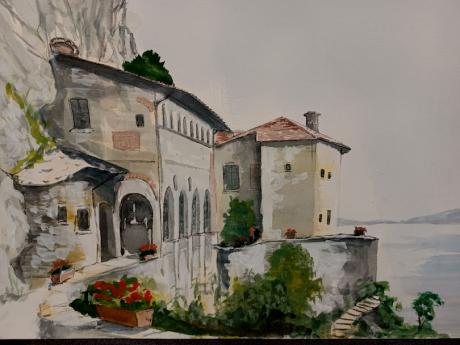" P Yates" and inscribed on the reverse
Unframed
Hermitage of Santa Caterina del Sasso (Italian: Eremo di Santa Caterina del Sasso) is a Roman Catholic monastery located in the municipality of Leggiuno, in the Province of Varese and the region of Lombardy, Italy. It is perched on a rocky ridge on the eastern shore of Lake Maggiore.
The monastery can be reached on foot by descending down a long winding stairway or by taking an elevator or by a number of ferry services or boats that dock at the pier. The construction of the monastery dates from the 14th century, although the more recent frescos are from the 19th century. It consists of three buildings: the southern convent, the convent and the main church. In 1914 it was declared a national monument.
The hermitage was founded by the wealthy merchant, Alberto Besozzi in 1170. Whilst he was out in his boat one evening he was caught up in a storm and his boat capsized. He prayed to St Catherine to be saved and that if his prayers were answered he would give all his money to the poor and retire to live as a hermit. His prayers were answered and so he went to live in a cave as a hermit. In 1195 the plague struck the local population and he was asked for help. In return he asked the local people to build a votive chapel to St Catherine. In 1205 Alberto Besozzi died and he was buried near the St Catherine Chapel. People would come there and pray to be cured. In 1270 some noblemen from Ispra built the new St Mary Chapel after their town was miraculously freed from the wolves which were killing their livestock. People began to come to the complex to live as hermits and it is first documented as a hermitage in 1301 and as they chose a spiritual path in life, the hermitage gained canonical status in 1334. Extending the complex, some noblemen from Intra left land to build the St Nicholas Chapel which contains frescoes dating from between 1300 and 1320. In 1620 the hermitage reached its maximum size with 14 brothers living there. During the 1700's and the Enlightenment reforms in Lombardy, the St Catherine Hermitage was on the list of minor religious orders to be suppressed and in 1770 the remaining 6 brothers left. Thereafter the hermitage went into decline and its precarious position clinging to the rocks above the lake meant that the foundations became weak. In 1914 the Italian government made the hermitage into a national monument and then in 1970 it passed into the hands of the Varese Province authorities. Due to the problems of potential landslides and collapse major restoration works were undertaken before opening the complex to the public in 1986. The complex is made up of the South Convent, the Small Convent and the Church. Only the latter is now open to the public. The Church dates back to the end of the 16th century although you can see the signs of the three former churches in the three chapels on the land side. The altar-piece shows a scene of St Catherine with the Virgin and child and St Nicholas with Blessed Albert. The votive chapel is said to have the same dimensions as the sepulchre of St Catherine on Mount Sinai.

